正确解读检验报告单(2016)
- 格式:ppt
- 大小:3.81 MB
- 文档页数:62
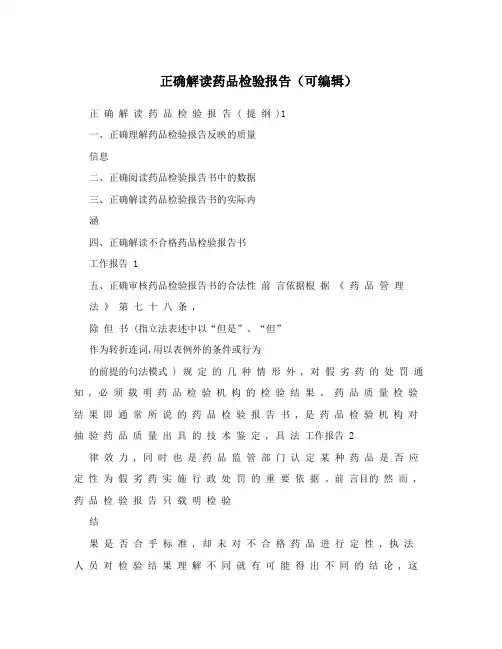
正确解读药品检验报告(可编辑)正确解读药品检验报告 ( 提纲 )1一、正确理解药品检验报告反映的质量信息二、正确阅读药品检验报告书中的数据三、正确解读药品检验报告书的实际内涵四、正确解读不合格药品检验报告书工作报告 1五、正确审核药品检验报告书的合法性前言依据根据《药品管理法》第七十八条 ,除但书 (指立法表述中以“但是”、“但”作为转折连词,用以表例外的条件或行为的前提的句法模式 ) 规定的几种情形外 , 对假劣药的处罚通知 , 必须载明药品检验机构的检验结果。
药品质量检验结果即通常所说的药品检验报告书 , 是药品检验机构对抽验药品质量出具的技术鉴定 , 具法工作报告 2 律效力 , 同时也是药品监管部门认定某种药品是否应定性为假劣药实施行政处罚的重要依据。
前言目的然而 , 药品检验报告只载明检验结果是否合乎标准 , 却未对不合格药品进行定性 , 执法人员对检验结果理解不同就有可能得出不同的结论 , 这直接影响监管部门对药品生产、经营企业和使用单位药品质量的定性和行政处罚决定 , 关系到药品生产、经营企业和使用单位的利益和声誉 , 甚至影响其生存。
工作报告 3意义因此 , 正确解读药品检验报告 , 对判定假劣药品 , 依法实施行政处罚具有相当重要的意义。
一、正确理解药品检验报告所反映的质量信息( 一 ) 、理解药品标准是解读检验报告的前提药品标准是国家对药品的质量、规格和检验方法所作的技术规定 , 是保证药品质量 , 进行药品生产、经营、使用、管理及监督检验的法定依据 , 是药品生产、流通、使用和监督检验中各环节、各单位所必须共同遵守的强制性标准。
药品标准包括二大部分 :1 必须经过药品检验机构检验的事项 , 如工作报告 4成份、规格、含量、允许的杂质及其限量、质量要求等 ;2 无需经过药品检验机构进行专门技术检验的事项 , 如药品的通用名称、功能主治、适应症、有效期、生产批号等。
一、正确理解药品检验报告所反映的质量信息通常所说药品检验合格与否实际上是指所检验的项目是否符合规定 , 但检验项目合格不等同于药品符合国家药品标准。
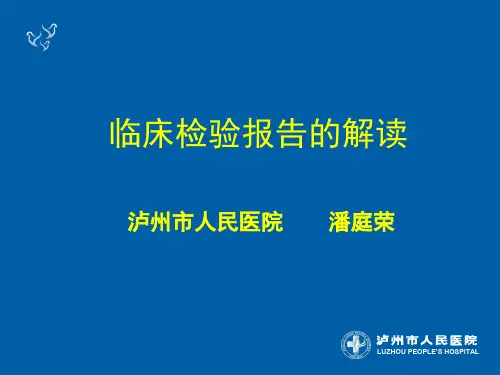
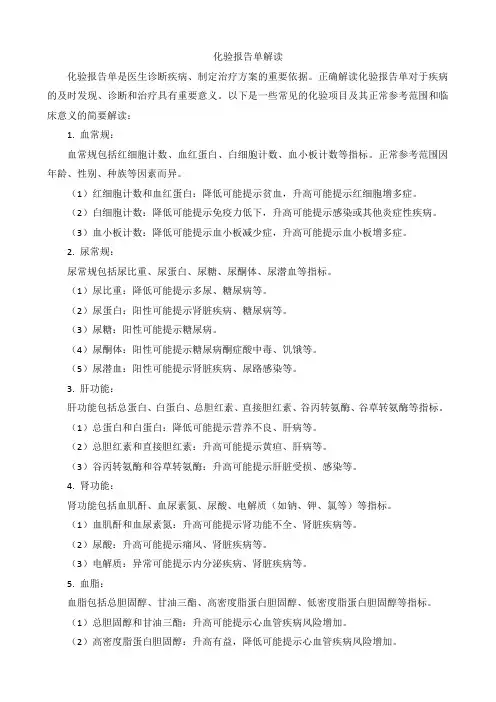
化验报告单解读化验报告单是医生诊断疾病、制定治疗方案的重要依据。
正确解读化验报告单对于疾病的及时发现、诊断和治疗具有重要意义。
以下是一些常见的化验项目及其正常参考范围和临床意义的简要解读:1. 血常规:血常规包括红细胞计数、血红蛋白、白细胞计数、血小板计数等指标。
正常参考范围因年龄、性别、种族等因素而异。
(1)红细胞计数和血红蛋白:降低可能提示贫血,升高可能提示红细胞增多症。
(2)白细胞计数:降低可能提示免疫力低下,升高可能提示感染或其他炎症性疾病。
(3)血小板计数:降低可能提示血小板减少症,升高可能提示血小板增多症。
2. 尿常规:尿常规包括尿比重、尿蛋白、尿糖、尿酮体、尿潜血等指标。
(1)尿比重:降低可能提示多尿、糖尿病等。
(2)尿蛋白:阳性可能提示肾脏疾病、糖尿病等。
(3)尿糖:阳性可能提示糖尿病。
(4)尿酮体:阳性可能提示糖尿病酮症酸中毒、饥饿等。
(5)尿潜血:阳性可能提示肾脏疾病、尿路感染等。
3. 肝功能:肝功能包括总蛋白、白蛋白、总胆红素、直接胆红素、谷丙转氨酶、谷草转氨酶等指标。
(1)总蛋白和白蛋白:降低可能提示营养不良、肝病等。
(2)总胆红素和直接胆红素:升高可能提示黄疸、肝病等。
(3)谷丙转氨酶和谷草转氨酶:升高可能提示肝脏受损、感染等。
4. 肾功能:肾功能包括血肌酐、血尿素氮、尿酸、电解质(如钠、钾、氯等)等指标。
(1)血肌酐和血尿素氮:升高可能提示肾功能不全、肾脏疾病等。
(2)尿酸:升高可能提示痛风、肾脏疾病等。
(3)电解质:异常可能提示内分泌疾病、肾脏疾病等。
5. 血脂:血脂包括总胆固醇、甘油三酯、高密度脂蛋白胆固醇、低密度脂蛋白胆固醇等指标。
(1)总胆固醇和甘油三酯:升高可能提示心血管疾病风险增加。
(2)高密度脂蛋白胆固醇:升高有益,降低可能提示心血管疾病风险增加。
(3)低密度脂蛋白胆固醇:升高可能提示心血管疾病风险增加。
6. 血糖:血糖升高可能提示糖尿病。
7. 甲状腺功能:甲状腺功能包括促甲状腺激素(TSH)、甲状腺激素(T3、T4)等指标。
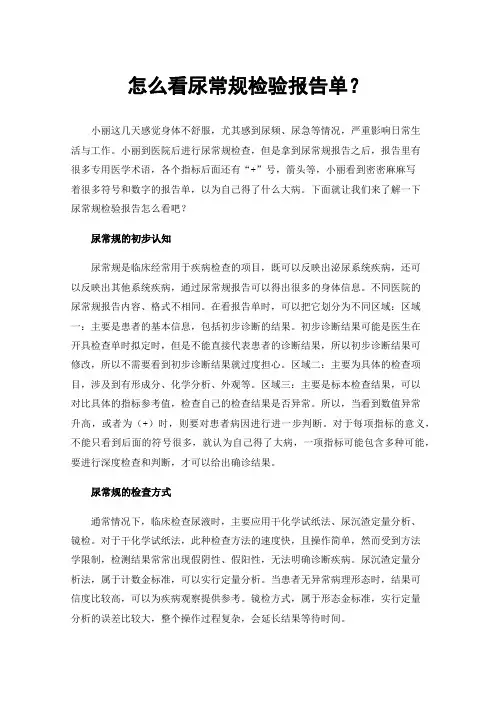
怎么看尿常规检验报告单?小丽这几天感觉身体不舒服,尤其感到尿频、尿急等情况,严重影响日常生活与工作。
小丽到医院后进行尿常规检查,但是拿到尿常规报告之后,报告里有很多专用医学术语,各个指标后面还有“+”号,箭头等,小丽看到密密麻麻写着很多符号和数字的报告单,以为自己得了什么大病。
下面就让我们来了解一下尿常规检验报告怎么看吧?尿常规的初步认知尿常规是临床经常用于疾病检查的项目,既可以反映出泌尿系统疾病,还可以反映出其他系统疾病,通过尿常规报告可以得出很多的身体信息。
不同医院的尿常规报告内容、格式不相同。
在看报告单时,可以把它划分为不同区域:区域一:主要是患者的基本信息,包括初步诊断的结果。
初步诊断结果可能是医生在开具检查单时拟定时,但是不能直接代表患者的诊断结果,所以初步诊断结果可修改,所以不需要看到初步诊断结果就过度担心。
区域二:主要为具体的检查项目,涉及到有形成分、化学分析、外观等。
区域三:主要是标本检查结果,可以对比具体的指标参考值,检查自己的检查结果是否异常。
所以,当看到数值异常升高,或者为(+)时,则要对患者病因进行进一步判断。
对于每项指标的意义,不能只看到后面的符号很多,就认为自己得了大病,一项指标可能包含多种可能,要进行深度检查和判断,才可以给出确诊结果。
尿常规的检查方式通常情况下,临床检查尿液时,主要应用干化学试纸法、尿沉渣定量分析、镜检。
对于干化学试纸法,此种检查方法的速度快,且操作简单,然而受到方法学限制,检测结果常常出现假阴性、假阳性,无法明确诊断疾病。
尿沉渣定量分析法,属于计数金标准,可以实行定量分析。
当患者无异常病理形态时,结果可信度比较高,可以为疾病观察提供参考。
镜检方式,属于形态金标准,实行定量分析的误差比较大,整个操作过程复杂,会延长结果等待时间。
尿常规检验报告单的内容解读在了解多数信息之后,基本可以判断尿常规化验单上的数据。
尿常规化验单上的指标,包括尿蛋白、尿比重、白细胞、酸碱度、尿液颜色、尿糖、尿胆原、胆红素、尿红细胞等。

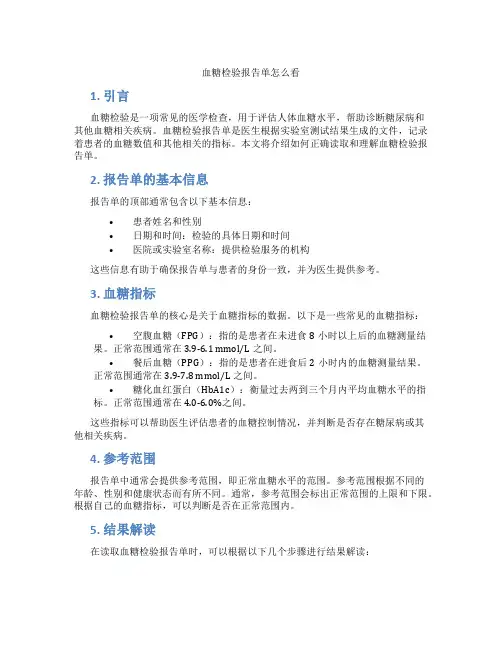
血糖检验报告单怎么看1. 引言血糖检验是一项常见的医学检查,用于评估人体血糖水平,帮助诊断糖尿病和其他血糖相关疾病。
血糖检验报告单是医生根据实验室测试结果生成的文件,记录着患者的血糖数值和其他相关的指标。
本文将介绍如何正确读取和理解血糖检验报告单。
2. 报告单的基本信息报告单的顶部通常包含以下基本信息:•患者姓名和性别•日期和时间:检验的具体日期和时间•医院或实验室名称:提供检验服务的机构这些信息有助于确保报告单与患者的身份一致,并为医生提供参考。
3. 血糖指标血糖检验报告单的核心是关于血糖指标的数据。
以下是一些常见的血糖指标:•空腹血糖(FPG):指的是患者在未进食8小时以上后的血糖测量结果。
正常范围通常在3.9-6.1 mmol/L之间。
•餐后血糖(PPG):指的是患者在进食后2小时内的血糖测量结果。
正常范围通常在3.9-7.8 mmol/L之间。
•糖化血红蛋白(HbA1c):衡量过去两到三个月内平均血糖水平的指标。
正常范围通常在4.0-6.0%之间。
这些指标可以帮助医生评估患者的血糖控制情况,并判断是否存在糖尿病或其他相关疾病。
4. 参考范围报告单中通常会提供参考范围,即正常血糖水平的范围。
参考范围根据不同的年龄、性别和健康状态而有所不同。
通常,参考范围会标出正常范围的上限和下限。
根据自己的血糖指标,可以判断是否在正常范围内。
5. 结果解读在读取血糖检验报告单时,可以根据以下几个步骤进行结果解读:•首先,了解自己的血糖指标数值,并与参考范围进行对比。
如果数值在正常范围内,通常表示血糖水平正常。
如果数值高于或低于正常范围,可能需要进一步咨询医生。
•其次,关注血糖指标的变化趋势。
如果前后的血糖指标差异较大,可能需要密切监测血糖,并咨询医生以获取进一步的指导。
•此外,还可以注意其他相关指标,例如HbA1c。
HbA1c可以反映过去几个月内的血糖控制情况,对于评估患者的长期血糖管理效果具有重要意义。

教你读懂检验报告单检验报告单是医疗机构为了诊断和治疗患者的疾病,对其进行的一系列检查和测试的结果的记录。
医生根据检验报告单上的数据,可以判断患者的健康状况,以及是否需要采取进一步的治疗。
读懂检验报告单需要掌握一些基本的医学知识和相关术语。
下面是一些常见的项目和其对应的解释,帮助我们更好地理解检验报告单。
1. 血常规:血常规是指对血液中各种成分的定量和定性的检测。
包括血红蛋白、红细胞计数、白细胞计数和血小板计数等。
这些指标可以反映出患者的贫血程度、感染情况等。
2. 尿常规:尿常规检测是对尿液中各种物质的含量和性质进行定性和定量的检查。
包括尿液的颜色、透明度、PH值、蛋白质、糖分和白细胞等指标。
这些指标可以反映出患者的肾功能和尿液中是否有炎症反应等。
3. 肝功能:肝功能检测主要包括血清转氨酶、总胆红素、碱性磷酸酶、尿胆原等指标。
这些指标可以用来评估患者的肝脏功能和肝脏的病变情况。
4. 肾功能:肾功能检测主要包括血清肌酐、尿素氮、尿酸等指标。
这些指标可以用来评估患者的肾脏功能和肾脏的排泄能力。
5. 血糖:血糖检测可以评估患者的血糖水平。
高血糖可能表示患者有糖尿病或其他胰岛素分泌异常的问题。
除了以上常见的项目,检验报告单还可能包括血脂、电解质、凝血功能等检查项目。
读懂检验报告单需要根据自身的情况和医生的解释进行综合分析。
在读懂检验报告单时,我们可以将报告单上的数据和正常参考范围进行对比。
正常参考范围是医学研究根据大量的健康人群的平均值和标准差得出的数据范围。
如果某项指标的结果在正常参考范围之内,通常说明患者的身体功能正常;如果某项指标的结果超出正常参考范围,可能表示患者存在某种健康问题,需要进一步的检查和治疗。
此外,读懂检验报告单还需要了解一些常见的异常指标和其可能的疾病关联。
例如,肾功能指标异常可能与肾炎、肾结石、肾衰竭等疾病有关;血常规指标异常可能与贫血、感染等疾病有关。
最后,读懂检验报告单还需要和医生进行沟通和解释。
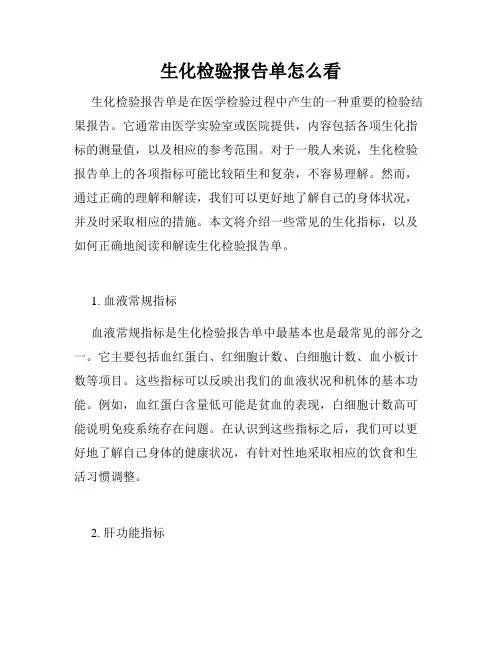
生化检验报告单怎么看生化检验报告单是在医学检验过程中产生的一种重要的检验结果报告。
它通常由医学实验室或医院提供,内容包括各项生化指标的测量值,以及相应的参考范围。
对于一般人来说,生化检验报告单上的各项指标可能比较陌生和复杂,不容易理解。
然而,通过正确的理解和解读,我们可以更好地了解自己的身体状况,并及时采取相应的措施。
本文将介绍一些常见的生化指标,以及如何正确地阅读和解读生化检验报告单。
1. 血液常规指标血液常规指标是生化检验报告单中最基本也是最常见的部分之一。
它主要包括血红蛋白、红细胞计数、白细胞计数、血小板计数等项目。
这些指标可以反映出我们的血液状况和机体的基本功能。
例如,血红蛋白含量低可能是贫血的表现,白细胞计数高可能说明免疫系统存在问题。
在认识到这些指标之后,我们可以更好地了解自己身体的健康状况,有针对性地采取相应的饮食和生活习惯调整。
2. 肝功能指标肝功能是生化检验报告单中重要的一部分,主要包括总蛋白、白蛋白、球蛋白、谷丙转氨酶(ALT)等项目。
肝脏作为人体最大的代谢器官,负责多种重要物质的合成与代谢。
如果肝脏功能有问题,往往会对人体的健康带来不良影响。
例如,ALT指标升高可能意味着肝脏受损。
因此,通过定期检测肝功能,我们可以及早发现肝脏的问题,并采取相应的治疗方法。
3. 肾功能指标肾功能是生化检验报告单中不可忽视的一部分。
主要包括尿素氮、血肌酐、尿酸等项目。
肾脏负责排除体内的废物和毒素,维持体内液体和电解质的平衡。
如果肾功能出现异常,身体很容易出现水肿、尿液颜色异常等问题。
因此,了解自己的肾功能状况,可以及时避免饮食和生活方式对肾脏产生不良影响,保护好自己的肾脏健康。
4. 血脂指标血脂指标主要包括总胆固醇、高密度脂蛋白胆固醇(HDL-C)、低密度脂蛋白胆固醇(LDL-C)等项目。
血脂异常是很多心血管疾病的重要原因之一。
如果总胆固醇或LDL-C含量过高,可能增加心脑血管疾病的风险。
而HDL-C则被认为可以保护心脑血管健康。
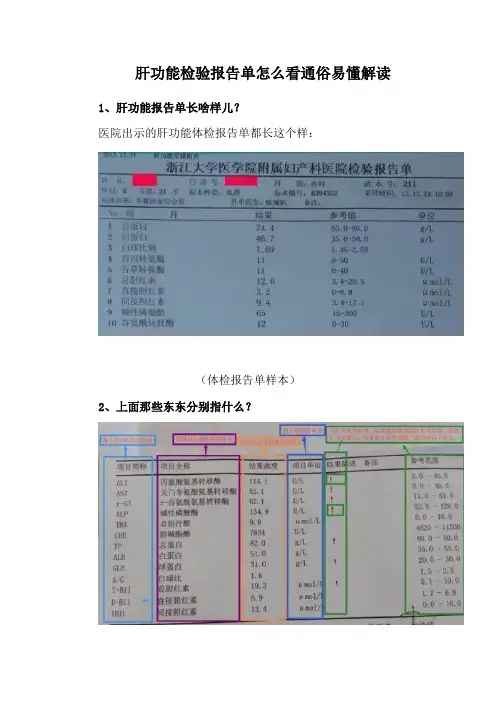
肝功能检验报告单怎么看通俗易懂解读1、肝功能报告单长啥样儿?医院出示的肝功能体检报告单都长这个样:(体检报告单样本)2、上面那些东东分别指什么?项目简称:即每个项目的英文简称项目全称:即反映肝功能的各项指标结果浓度:即患者体内各项指标的浓度项目单位:即每个指标的计量单位结果描述:即患者体检结果与参考值相比,是否异常参考范围:即每项指标的正常值3、给项目分个类每个医院的肝功能体检项目千差万别,事实上多数时候,我们看这12个指标就可以了,如下图所示:看看这些项目的名称,有何启发?是不是可以给他们分个类啊!按照临床意义的不同,我们一般把这12个指标分为三类,这样解读就更容易:1.反映肝脏受损情况:即肝细胞是否受损,如果受损,有多严重?主要看3个指标(见上表)2.反映肝脏合成情况:即肝细胞合成蛋白质的能力是否异常。
有时肝细胞受损,但合成能力依旧正常,就像人受伤了依旧能走路一样。
主要看4个指标(见上表)3.反映肝脏胆红素代谢及胆汁淤积情况:即肝细胞中的胆红素代谢是否异常,如果代谢正常,是否发生其他原因的堵塞现象。
主要看5个指标(见上表)4、每个体检项目有何意义要想准确读懂报告,就要清楚理解每个项目的前世今生,不要怕,以下描述都是人话,绝对看得懂。
一、反映肝脏受损情况的指标A.谷丙转氨酶(ALT)有些报告单会写它的医学术语【丙氨酸氨基转移酶】,一回事儿。
ALT(以下都用英文简称)主要分布在肝细胞的细胞浆中,是肝细胞受损最敏感的指标之一。
当肝细胞坏死时,ALT会释放到血液中,导致血液里的ALT浓度猛增。
说明:ALT也分布在心脏的心肌细胞中,所以你不能看到ALT升高就说肝脏有问题,也可能是心脏有问题。
正确的说法是,ALT升高,肝脏不一定有问题;但肝脏出问题,ALT一定升高。
B.谷草转氨酶(AST)有些报告单会写它的医学术语【天门冬氨酸氨基转移酶】,一回事儿。
AST主要分布在肝细胞的线粒体中,也是肝细胞受损最敏感的指标之一。

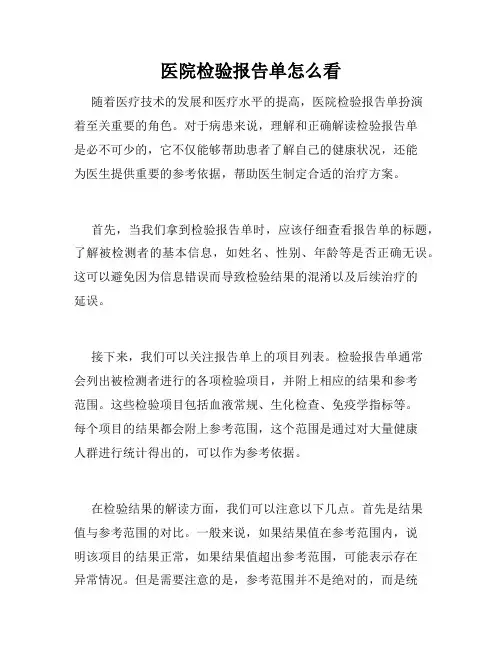
医院检验报告单怎么看随着医疗技术的发展和医疗水平的提高,医院检验报告单扮演着至关重要的角色。
对于病患来说,理解和正确解读检验报告单是必不可少的,它不仅能够帮助患者了解自己的健康状况,还能为医生提供重要的参考依据,帮助医生制定合适的治疗方案。
首先,当我们拿到检验报告单时,应该仔细查看报告单的标题,了解被检测者的基本信息,如姓名、性别、年龄等是否正确无误。
这可以避免因为信息错误而导致检验结果的混淆以及后续治疗的延误。
接下来,我们可以关注报告单上的项目列表。
检验报告单通常会列出被检测者进行的各项检验项目,并附上相应的结果和参考范围。
这些检验项目包括血液常规、生化检查、免疫学指标等。
每个项目的结果都会附上参考范围,这个范围是通过对大量健康人群进行统计得出的,可以作为参考依据。
在检验结果的解读方面,我们可以注意以下几点。
首先是结果值与参考范围的对比。
一般来说,如果结果值在参考范围内,说明该项目的结果正常,如果结果值超出参考范围,可能表示存在异常情况。
但是需要注意的是,参考范围并不是绝对的,而是统计得出的一般范围,因此个体差异和不同情况下的变化是很正常的。
其次,对于检验结果的异常情况,我们需要结合自身的病情、症状等综合分析。
举个例子,血红蛋白(Hb)值偏低可能表示贫血,但贫血有许多种原因,可能是由于缺铁、维生素B12或叶酸等物质缺乏引起的。
因此,在解读检验结果时,我们需要将其与临床表现和其他检查结果相结合,才能得到更准确的诊断。
此外,报告单上可能还会附有医生的解读和建议。
这部分内容对于患者来说尤为重要,可以进一步了解医生对检验结果的看法以及后续治疗和饮食方面的建议。
如果患者对医生的解读有疑问或不理解的地方,应当及时与医生或相关医疗工作人员沟通,以保证自己能够全面理解报告单内容。
最后值得一提的是,每个人的身体状况、生活习惯以及所接受的治疗方案都有所不同,因此在解读检验报告单时,不能仅仅依据结果值和参考范围,而是需要结合个人情况进行判断和分析。
医院检验报告单解读目录1. 解读医院检验报告单1. 血常规检验2. 尿常规检验3. 血糖检测4. 肝功能检查5. 肾功能检查6. 血脂检测7. 血液凝血功能检查8. 血尿酸检测9. 其他检查项目1.1 血常规检验血常规检验是一项常规的检查项目,通过检测血液中的各种指标来了解人体的健康状况。
血常规包括白细胞计数、红细胞计数、血红蛋白浓度、血小板计数等指标。
根据这些指标的正常范围和异常情况,可以初步判断患者是否存在感染、贫血、出血等情况。
1.2 尿常规检验尿常规检验是通过检测尿液中的各种成分来评估肾脏功能和全身健康状况的一项检查。
尿常规检验包括尿液的颜色、透明度、PH值、尿蛋白、尿糖、尿酮体等指标。
通过尿常规检验可以了解肾脏功能、糖尿病、泌尿系统疾病等情况。
1.3 血糖检测血糖检测是用来评估血糖水平的一项检查。
高血糖可能是糖尿病等代谢性疾病的表现,而低血糖可能是胰岛功能异常或胰岛素过量的表现。
通过血糖检测可以及时发现和管理血糖异常,预防疾病的发生。
1.4 肝功能检查肝功能检查是评估肝脏功能的一项重要检查项目。
通过测定血清中的丙氨酸氨基转移酶(ALT)、天门冬氨酸氨基转移酶(AST)、碱性磷酸酶(ALP)等酶的活性和总蛋白、白蛋白、胆红素等参数,可以了解肝脏是否受损、程度如何。
1.5 肾功能检查肾功能检查是评估肾脏功能的一项重要检查项目。
通过测定血清中的肌酐、尿素氮等指标,可以了解肾小球滤过功能和肾小管功能的健康状况。
肾功能检查还包括尿液的蛋白定性、定量等项目。
1.6 血脂检测血脂检测是评估血液中脂质代谢情况的一项检查。
主要包括总胆固醇、甘油三酯、高密度脂蛋白胆固醇、低密度脂蛋白胆固醇等指标。
通过血脂检测可以评估心血管疾病的风险,及时干预预防心脑血管疾病的发生。
1.7 血液凝血功能检查血液凝血功能检查是评估血液中凝血系统功能的一项检查项目。
通过测定凝血相关蛋白、凝血酶时间、凝血酶原时间、纤维蛋白原等指标,可以了解患者的凝血功能状态,判断出血和栓塞的风险。
血清检验报告单怎么看
血清检验报告单是一份包含血液检查结果的文件,下面是查看血清检验报告单的一般步骤:
1. 了解基本信息:检查日期、报告单号、个人基本信息(姓名、性别、年龄、医院等)等。
2. 检查项目列表:查看报告单上列出的各项检查项目。
3. 参考值范围:了解每个检查项目的正常参考值范围。
参考值通常会标明正常范围的上下限,以与个人实际值进行比较。
4. 结果解读:根据每个项目的数值,与正常参考范围比较,判断该项检查结果是否正常。
通常,如果检查结果在正常范围内,会标注“正常”或者“在正常范围内”;如果超出正常范围,会标
注具体的数值,并且表示异常。
5. 异常指示:如果有检查结果异常,报告单上可能会标明相关的异常指示或备注,这些指示可能是进一步的检查或治疗建议。
6. 注意事项:报告单上可能还会提供一些特别注意事项或者实施建议,例如饮食、运动、药物使用等。
7. 解读与咨询:在查看报告单后,如果有任何疑问或需要进一步解读,最好咨询医生或相关专业人员,以获得更准确的解释和建议。
请注意,每个报告单可能会有一些差异,具体的查看方法可以根据报告单上的提示进行。
此外,如果您对某个检查项目的具体含义不清楚,最好向医生请教,以获得更准确的解释。
免疫检验报告单怎么看免疫检验报告单是指通过实验室检测,对人体的免疫系统进行评估的一种检验报告。
它主要用于检测身体的免疫功能,包括免疫球蛋白、免疫细胞、免疫介质等指标。
通过免疫检验报告单的分析,可以帮助医生了解病人的免疫系统状况,从而指导临床诊断和治疗方案的制定。
在看免疫检验报告单时,首先需要注意的是报告单的基本信息,包括患者姓名、性别、年龄、样本采集日期等。
这些信息对于报告单的解读和分析至关重要,因为不同年龄、性别、甚至不同时间采集的样本,其免疫指标的正常范围都可能有所不同。
其次,需要仔细查看报告单中的各项指标及其对应的数值。
免疫检验报告单通常包括免疫球蛋白(IgA、IgG、IgM)、淋巴细胞亚群(CD4+T细胞、CD8+T细胞、CD4+/CD8+比值)、免疫介质(IL-2、IL-4、IL-6、TNF-α等)等指标。
这些指标的异常值可能提示着不同的免疫系统问题,比如免疫缺陷、自身免疫性疾病、感染等。
在看报告单时,需要将各项指标的数值与正常参考范围进行比较。
如果某项指标的数值超出了正常范围,就需要引起重视。
但需要注意的是,免疫检验报告单只是一个辅助诊断的工具,不能单独用来判断疾病的诊断和治疗。
因此,在看报告单时,一定要结合临床症状、体征和其他检查结果进行综合分析。
此外,免疫检验报告单中的指标数值还需要考虑到个体差异和实验室方法的不同。
有些人可能在健康状态下,其某项指标的数值就会略高或略低,这就需要结合临床情况进行判断。
同时,不同实验室的检测方法和参考范围也可能有所不同,因此在不同实验室检测的报告单需要注意参考范围的差异。
最后,需要强调的是,在看免疫检验报告单时,一定要结合专业医生的指导和建议进行分析和判断。
免疫系统是一个复杂的系统,其异常状况可能涉及多个因素,需要专业医生进行综合分析和诊断。
因此,如果发现免疫检验报告单中有异常指标,一定要及时就医,并在医生的指导下进行进一步的检查和治疗。
综上所述,免疫检验报告单的解读需要仔细查看基本信息、各项指标的数值及其参考范围,并结合临床情况进行综合分析。
给市长写信'解决交通拥堵问题英语作文全文共3篇示例,供读者参考篇1Dear Mayor,I'm writing to you today as a concerned student about the traffic congestion issues that have been plaguing our city. As someone who has to commute to school and other activities, I've experienced firsthand the frustrations of being stuck in gridlocked traffic for extended periods. Not only is it an incredible waste of time, but it also contributes to increased air pollution, higher stress levels, and a general decrease in quality of life for our city's residents.I understand that tackling traffic congestion is a complex challenge with no simple solution. However, I believe that by implementing a comprehensive strategy that combines infrastructure improvements, public transportation enhancements, and innovative policies, we can make significant progress in alleviating this problem.One of the primary contributors to traffic congestion is our city's outdated and inadequate road infrastructure. Many of ourstreets and highways were designed decades ago when the population and the number of vehicles on the road were much lower. As our city has grown, these roads have become increasingly overwhelmed, leading to bottlenecks and gridlock during peak hours.To address this issue, I propose investing in the expansion and modernization of our road network. This could involve widening existing roads, constructing new highways and bypass routes, and implementing intelligent traffic management systems that can dynamically adjust signal timings and provide real-time traffic information to drivers.Additionally, we should prioritize the maintenance and repair of our existing roads. Potholes, crumbling pavement, and other infrastructure deficiencies not only create safety hazards but also contribute to traffic slowdowns and congestion.While improving our road infrastructure is crucial, we cannot simply build our way out of this problem. We must also focus on enhancing and promoting the use of public transportation as a viable alternative to personal vehicles.Our city's public transportation system, while commendable, still has significant room for improvement. Increasing the frequency and reliability of bus and train services, expandingroutes to underserved areas, and improving the overall user experience can make public transit a more attractive option for commuters.Furthermore, we should explore the integration of new technologies, such as on-demand ride-sharing services and autonomous vehicles, into our public transportation ecosystem. These innovations have the potential to increase accessibility, reduce costs, and provide more efficient and environmentally friendly transportation options.In addition to infrastructure improvements and public transportation enhancements, we should also consider implementing policies and incentives that encourage alternative modes of transportation and discourage the overreliance on personal vehicles.One effective strategy could be the implementation of congestion pricing or toll systems during peak hours inhigh-traffic areas. This would not only generate revenue that could be reinvested in transportation infrastructure but also incentivize people to consider alternative modes of transportation or adjust their travel times to avoid the highest fees.Another policy worth exploring is the promotion of telecommuting and flexible work schedules. By allowing employees to work remotely or stagger their commute times, we can reduce the number of vehicles on the road during peak hours, alleviating traffic congestion.Additionally, we should invest in improving pedestrian and bicycle infrastructure, such as dedicated bike lanes, pedestrian-friendly street designs, and secure bike parking facilities. Encouraging active transportation not only reduces congestion but also promotes healthier lifestyles and a more sustainable urban environment.Education and awareness campaigns are also crucial in changing the mindset and behavior of our city's residents. By promoting the benefits of public transportation, carpooling, and active transportation, we can gradually shift the culture towards more sustainable and efficient transportation choices.I understand that implementing these measures will require significant financial investment, political will, and collaboration among various stakeholders. However, the long-term benefits of reducing traffic congestion, improving air quality, and enhancing the overall quality of life for our city's residents make these investments worthwhile.Traffic congestion is not just an inconvenience; it is a multifaceted issue that impacts our economy, environment, and overall well-being. By taking a comprehensive and innovative approach that addresses infrastructure, public transportation, policies, and behavioral changes, we can create a more efficient, sustainable, and livable city for all.I urge you, Mayor, to prioritize this issue and work towards implementing these solutions. As a student and a resident of our city, I am deeply invested in its future, and I believe that tackling traffic congestion is essential for ensuring a prosperous and livable community for generations to come.Thank you for your time and consideration.Sincerely,[Your Name]篇2Dear Mayor Johnson,I am writing to you today regarding the severe traffic congestion issues that have been plaguing our city for years. As a high school student, I witness firsthand the frustrations of being stuck in gridlock traffic on a daily basis. Not only is this a majorinconvenience, but it also has far-reaching negative impacts on our environment, economy, and quality of life. I implore you to make addressing this crisis a top priority during your term.My commute to school, which should only take 20 minutes, routinely takes over an hour due to heavy traffic volumes on the main arteries. Waiting in stop-and-go traffic is mentally draining and robs us students of valuable time that could be better spent studying, participating in extracurricular activities, or simply relaxing after a long day. The wasted time and productivity loss due to congestion is staggering when extrapolated across our city's workforce and student population.Beyond just inconveniencing commuters, traffic congestion has severe environmental repercussions that cannot be ignored. Idling vehicles stuck in traffic are needlessly pumping greenhouse gas emissions into our air, worsening air quality and contributing to climate change. The negative health impacts on our citizens, especially those with respiratory issues, is a major concern. We should be promoting sustainable transportation alternatives and optimizing traffic flow to minimize harmful emissions.Furthermore, congestion hurts our city's economic competitiveness and reputation. Companies may be reluctant torelocate or expand operations here due to concerns over employees being stuck in gridlock purgatory during their commutes. We run the risk of losing out on invaluable jobs, tax revenue, and talent exodus to other municipalities that have more efficient transportation networks. Our city's livability ratings have already dropped due to the congestion problems. If left unchecked, this crisis could spiral into an economic burden that impacts our ability to fund critical services and infrastructure improvements.Having outlined the scope of the issue, I would like to propose some potential solutions that your administration should strongly consider:Improve public transit infrastructure and incentivesBy investing in enhancing our city's public transportation network and creating compelling incentives for citizens to utilize it, we can get many cars off the roads. Expanding bus and rail services with more routes, higher frequencies, andpark-and-ride facilities is crucial. Additionally, working with employers to subsidize transit passes and implementing congestion pricing schemes can further motivate public transit adoption.Promote active transportation modesBike lanes, better sidewalks, and pedestrian-friendly infrastructure would empower citizens to bike, walk, or use other micro-mobility solutions for short trips instead of driving. This reduces total vehicle volumes while also promoting public health through physical activity. Building protected cycle tracks separated from traffic and improving lighting/safety is key to making this viable.Implement intelligent transportation systems (ITS)By leveraging modern technology, we can drastically increase the efficiency of our streets through active traffic management. Investments in ITS solutions like smart signal systems, road sensors, incident response capabilities and citywide traffic monitoring can enable dynamic adjustments to traffic light timing and traffic routing. This prevents bottlenecks and clears pathways for designated priority traffic.Rethink urban planning and zoning policiesA lot of our congestion stems from outdated urban planning policies that promoted car-centric suburban sprawl. By allowing and incentivizing higher-density, mixed-use developments in appropriate areas, we can create communities whereWork/Live/Play is possible without excessive driving. Additionally, reworking zoning regulations around schools,businesses and neighborhoods to promote bettercycling/walking integration is needed.Explore telecommuting and flexible schedulesStaggering work times and promoting remote working options where feasible can drastically reduce peak travel demand that overloads our roads. Many jobs in today's information economy don't necessarily require physical presence in an office. Partnering with major employers to pilot these arrangements can be an impactful congestion mitigation strategy.While implementing many of these solutions will require substantial investments, I would argue that the costs of inaction are far higher. The productivity losses, environmental damages, public health impacts, and potential economic consequences make addressing this crisis fiscally prudent in the long run. With creative solutions drawing from international best practices, we can build a more sustainable, mobile future for our city.I, along with many of my peers, are counting on your leadership to prioritize viable congestion relief plans during your administration. We have inherited daunting challenges, but we owe it to future generations to course correct. An efficient, multi-modal transportation ecosystem is vital for our city tocontinue thriving and being a great place to live, work, and raise a family.Thank you for your time and consideration of the points raised in this letter. I look forward to seeing proactive steps to "untie" the Gordian Knot of gridlock paralyzing our streets. We students are prepared to actively support and advocate for smart policies that get our city moving again.Respectfully yours,Jamie FernandezSenior, Roosevelt High School篇3Dear Mayor Wilson,I am writing to you today regarding the increasingly problematic traffic congestion in our city. As a high school student who relies on buses and rides from parents to get to school and activities, I have become all too familiar with the frustrations of being stuck in gridlock traffic. The traffic situation in our city has reached a tipping point that is negatively impacting our community's quality of life, economic productivity,air quality, and overall efficiency. I implore you to make addressing this issue a top priority for the betterment of our city.Every weekday morning and afternoon, the main arteries feeding into and out of downtown become parking lots. Commuters can spend upwards of an hour cada way just getting a few miles down the road. For those relying on public transportation, the bus routes risk becoming ineffective and unreliable due to the perpetual congestion. The root causes stem from a combination of factors, including insufficient road capacity, traffic signal timing issues, population growth outpacing infrastructure improvements, and a lack of viable public transit options.The personal impacts of this crisis are far-reaching. Students like myself frequently arrive late to school after being stuck in gridlock, leading to disruptions in our education. Working parents face difficulties getting to their jobs in a timely manner. And local businesses suffer from potential customers avoiding the area due to the traffic nightmares. No one wins when our city remains in this state of continuous congestion.Looking around at other cities that have successfully combated similar traffic woes, there are proven strategies that our city would be wise to implement. In the short term,optimizing traffic signal timing through intelligent transportation systems could provide some relief by facilitating better traffic flow. Longer term solutions could include road expansions, creating more efficient traffic patterns, incentivizing carpooling, and most critically, investing heavily in reliable and far-reaching public transit options.A multi-pronged approach centered around an expansion of our public transit system would pay dividends. Cities like Denver, Dallas, and Los Angeles have seen decreases in traffic and increases in economic growth after building out comprehensive rail and bus networks that gave citizens alternative options to being stranded on the roads. Our public transit is virtuallynon-existent currently beyond a few token bus routes. Building light railLines, subway extensions, park and ride facilities, and dedicated bus rapid transit lanes integrated with mixed-use zoning could get countless numbers of cars off the roads.Looking beyond just the transit system itself, we could further reduce the number of vehicles on the roads by adopting more pedestrian and cyclist-friendly urban planning policies. Things like creating green belts and bike path networks, increasing zoning for mixed-use development so people can live closer to work/school, and redesigning roads with bike lanes,crosswalks, and slower speed limits would make getting around on foot or bike a more viable option for short trips around the city. Combined with a robust transit system for longer commutes, we could significantly decrease the number of single occupancy vehicle trips.There are also technologies we should leverage to ease congestion, such as smart traffic light systems that monitor traffic flows and adapt signal timing dynamically to optimize traffic flow. Intelligent highway radio systems could alert drivers of congestion and provide re-routing options. Ridesharing, cycling, and micro-transit options enabled through smartphone apps could reduce the number of cars on the roads per household. Better coordinated roadwork and event planning could minimize impacting major arteries. These types of relatively low-cost tech solutions exist and could make a real impact.While strategies like those mentioned above could offer relief, I understand that funding will be a major obstacle to implementing them. Therefore, I would suggest exploring sources of alternative funding, starting with seeking federal infrastructure grants as well as public-private partnerships. Many private companies have a vested interest in our city being anefficient place to move people, goods, and services. They may be willing partners to help get transit and road projects off the ground. Additionally, raising certain fees or implementing a city congestion charge on vehicles entering downtown could provide revenue streams to fund transit and road improvements.Mayor Wilson, I remind you that solving traffic has implications that go far beyond just reducing commute times. It impacts our city's economic competitiveness, our environment, our safety, our quality of life, and so much more. This issue demands a sense of urgency and bold, long-term thinking. I appeal to you to be a leader on this critical issue facing our city. Take the steps needed to develop and implement a comprehensive "Mobility Master Plan" that leverages all potential strategies and funding sources to accomplish the goals of reduced congestion, increased transit accessibility, and better urban planning. Our city's future depends on getting a handle on this problem.As a student, I look ahead and envision being able to one day live and work in this city without the absolute dread of being trapped on the roads for hours on end. A city's greatness stems in part from its ability to move people efficiently through intelligent infrastructure design. I believe with the rightinvestments and political will, our city can transform itself into a modern, mobile, and sustainable metropolis that becomes a model for others to follow. But it will take commitment from leaders like yourself to make it a reality.I am hopeful you will hear the calls from citizens like myself who are fed up with the status quo. We want real solutions implemented. The future prosperity of our city depends on conquering this issue once and for all. I eagerly await your action on this matter.Sincerely,[Your name]。